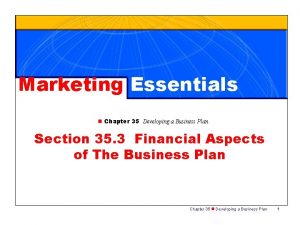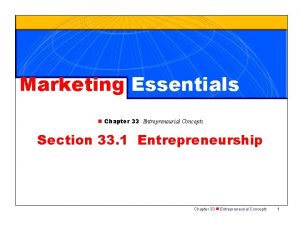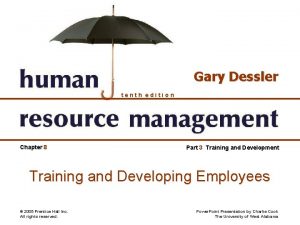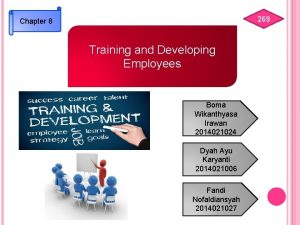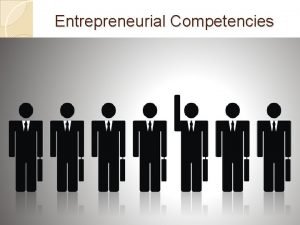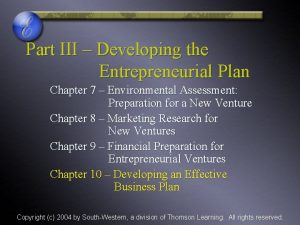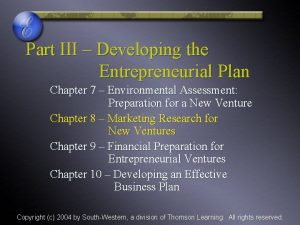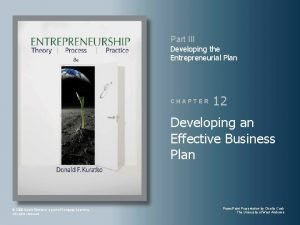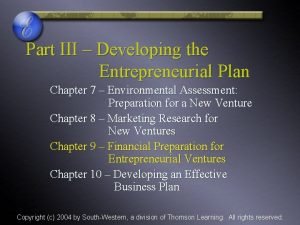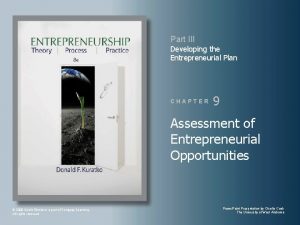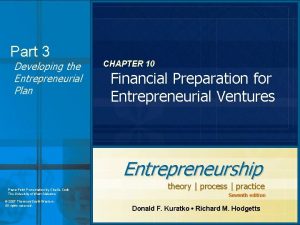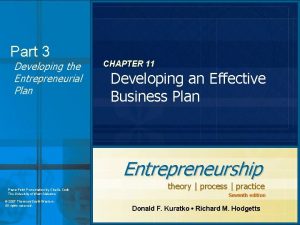Part III Developing the Entrepreneurial Plan Chapter 7






















- Slides: 22

Part III – Developing the Entrepreneurial Plan Chapter 7 – Environmental Assessment: Preparation for a New Venture Chapter 8 – Marketing Research for New Ventures Chapter 9 – Financial Preparation for Entrepreneurial Ventures Chapter 10 – Developing an Effective Business Plan Copyright (c) 2004 by South-Western, a division of Thomson Learning. All rights reserved.

Chapter 7 – Environmental Assessment: Preparation for a New Venture

The Environment for New Ventures

Environmental Scanning • Refers to the efforts by which an ownerentrepreneur examines the external and internal environments before making a decision. – Task environment – Societal environment

Environmental Variables SOCIETAL ENVIRONMENT TASK ENVIRONMENT (Industry) Sociocultural Forces Stockholders Supplies Governments Special Interest Groups INTERNAL ENVIRONMENT Structure Culture Resources Customers Creditors Political/Legal Forces Economic Forces Employees/ Labor Unions Competitors Trade Associations Communities Technological Forces

A Macro View: The Economic and Industry Environments

Assessing the Economic Environment

Understanding the Regulatory Environment

Governmental Regulations Affect Smaller Ventures in a Variety of Ways: • Prices • Cost inequities • Competitive restriction • Managerial restriction • Mental burden

Trends in Policy Formation • • The Regulatory Flexibility Act The Equal Access to Justice Act The Congressional Review Act The Small Business Regulatory Enforcement Fairness Act • The Paperwork Reduction Act • The Unfunded Mandates Reform Act

Examining the Industry Environment

Elements of Industry – The Five Forces Model New Entrants Threat of New Entrants Bargaining Power of Suppliers Industry Competitors Suppliers Bargaining Power of Buyers Intensity of Rivalry Threat of Substitutes

Common Industry Characteristics • Technological Uncertainty • Strategic Uncertainty • First-Time Buyers • Barriers to Entry • Competitive Analysis

Components of Competitive Analysis What Drives the Competitor What the Competitor is Doing and Can Do Future Goals Current Strategy Competitor’s Response Profile Assumptions Held about itself and the industry Capabilities Both strengths and weaknesses

A Micro View: The Community Perspective

Researching the Location • Community Demographics • Economic Base • Population Trends • Overall Business Climate

Determining Reliance and Deservedness

Reliance Versus Commitment: Development of Exceptional Community Support Community’s “Reliance (or Need) for the Venture High Exceptional Support Likely Some Support Likely Exceptional Support Unlikely Low Entrepreneur’s Willingness to Commit to Local Community (Loyalty) High

Deservedness vs. Identification: Development of Exceptional Community Support Perception of Entrepreneur’s Deservedness High Exceptional Support Likely Some Support Likely Exceptional Support Unlikely Low Community Identification with the Venture High

Examining the Use of Incubators Business incubator is a facility with adaptable space that small businesses can lease on flexible terms and at reduced rents.

Types of Incubators 1. Publicly Sponsored 2. Nonprofit-sponsored 3. University-related 4. Privately sponsored

How Does the Incubator Work? Commercial High Tech Research & Development Service Business Light Manufact. Wholesaler Retailer Mail Order Import/ Export Nonprofit • Potential to grow • Ability to create jobs • Ability to pay op. Expenses • Business plan • Market analysis • Cash-flow statement Business Entering the Incubator Business Developing Well. Established Business Growth Requires Move Out of Incubator
 Hamlet act iii scene iii
Hamlet act iii scene iii Chapter 35 developing a business plan
Chapter 35 developing a business plan Chapter 35 developing a business plan
Chapter 35 developing a business plan The pathways to new ventures for entrepreneurs
The pathways to new ventures for entrepreneurs Chapter 33 entrepreneurial concepts answers
Chapter 33 entrepreneurial concepts answers Va handbook 5017
Va handbook 5017 Pretest: developing an academic and career plan
Pretest: developing an academic and career plan Steps in sampling plan
Steps in sampling plan Strategic prospecting definition
Strategic prospecting definition Developing a personal wellness plan
Developing a personal wellness plan Plan ewakuacji iii stopnia
Plan ewakuacji iii stopnia Chapter 8 training and developing employees
Chapter 8 training and developing employees Chapter 15 developing fraction concepts
Chapter 15 developing fraction concepts Developing guidance skills
Developing guidance skills The central instrument for directing and coordinating
The central instrument for directing and coordinating Chapter 17:1 developing job-keeping skills
Chapter 17:1 developing job-keeping skills Chapter 8 training and developing employees
Chapter 8 training and developing employees Chapter 3 lesson 1 developing your self esteem
Chapter 3 lesson 1 developing your self esteem Developing a vast wilderness
Developing a vast wilderness Chapter 11 developing and managing products
Chapter 11 developing and managing products The marketing plan the central instrument
The marketing plan the central instrument Hát kết hợp bộ gõ cơ thể
Hát kết hợp bộ gõ cơ thể Ng-html
Ng-html

